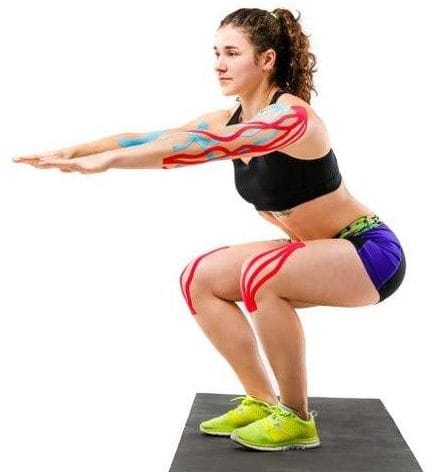Kinesio Taping a Combat Arts Training Recovery Revolution
Kinesio Taping (KT) is a revolutionary recovery and healing method composed of several different techniques utilizing Kinesio Taping to promote tissue healing, reduce pain, swelling, and spasm. Kinesio Taping also provides mechanical support when necessary for issues such as whiplash, and other neck injuries sprained ankles and back muscle spasms [1].
Kinesiology works on a wide variety of athletic injuries and physical conditions, and can also help increase physical endurance. Kinesio tape was created over 40 years ago in Japan by the chiropractor, Dr. Kenzo Kase, for treating sports injuries and a variety of other disorders.
MMA fighter Ben “The Badger” Jones
Believes kinesio taping is so important that he made a hand taping video to ensure hands are prepped right for combat! Check it out here, Hand Taping for MMA. KT is an elastic therapeutic tape that functions in ways that are only recently becoming understood through numerous research studies.
Athletes knew it worked for relieving pain, strengthening muscles, speeding recovery and healing, but the mechanisms by which it functioned have been unclear.
Doctors Affirm Kinesio Taping Helps Speed Recovery
Dr. Timothy Dutra, DPM, MS, MHCA is a Past President of the American Academy of Podiatric Sports Medicine, Fellow of the American Academy of Podiatric Sports Medicine, and has a list of credentials you can hang a hat on. Dr. Dutra is a definite believer when it comes to kinesio taping for the recovery of athletes and other patients.

Dr. Timothy Dutra
DPM, MS, MHCA
Coming from an athletic training background, I was introduced to the benefits of taping and padding early in my career. Much of the principles and techniques that I have used are from core principles in athletic training, which we incorporate into our biomechanical skills course at the California School of Podiatric Medicine. Taping and padding should be an integral part of every podiatrist’s practice. Taping is both an art and science that offers the patient and doctor many benefits: reduced pain, increased function and a predictor for orthotic therapy based on a patient’s response to taping and padding”.
First Dedicated Kinesio for Recovery Conference in the UK Held at Therapy Expo
The Therapy Expo held in the UK in 2016 held its first conference focused on kinesio taping. The primary session was called, The variability, treatment, and support Kinesio Tape have in the athletic and musculoskeletal environment.
Learn More About Kinesio-Taping
AND How It Can Help You Recover Faster!
The session was given by Chris Boynes, who worked with elite athletes for over 20 years, across a wide variety of sports, and has been a consultant for many difficult Musculoskeletal cases. Chris Boynes says Kinesio Taping can benefit a wide variety of musculoskeletal and sports injuries.
Kinesio Tape Moves with the Body
Kinesio tape is an elastic therapeutic tape that moves with the body. Kinesio Taping is extremely flexible, permitting full function and motion for work or play, training or sparring. The purpose KT is applied to perform is what dictates the manner in which the tape is placed upon the muscles and body.
The elasticity prevents overstretching of injured and healing muscles, or applied differently, provides muscle support while still maintaining a full range of motion. Applied yet another way, Kinesio Taping will lift the skin, helping to relieve pain and pressure, while improving blood circulation and drainage, getting employees back to work, and athletes back to training again.
Kinesio Taping for Martial Arts Recovery
Kinesio taping is an extremely popular therapeutic method widely utilized among martial artists for recovery, pain reduction, controlling inflammation, strengthening weakened areas compromised by injury, stress, illness, and overtraining. One obvious reason for this extreme popularity is the fact that the Kinesio Taping application can be easily learned for use on simple, very common injuries, such as knee and ankle sprains.

This application can be used for a variety of ankle issues including ankle strains and sprains, stretched ligaments, inflamed tendons, or general ankle weakness.
How Kinesio Taping Helps Recovery
The exact mechanisms explaining how Kinesio Taping functions within the body are the subject of many ongoing studies. According to research already performed, it appears that Kinesio Taping reduces pain and quickens recovery by helping facilitate the body’s natural healing systems through a variety of different processes.
Kinesio Taping is believed to speed recovery by:
Physical Effort Causes Fatigue and Changes In The Body
Physical muscle fatigue can result from intense exercise sustained for a long duration. There are many changes caused in muscular tissue by exercise and physical effort, including damages to muscle fibers, microtrauma to bones, pain during and after exercise, inflammation, and fatigue, along with other system changes.

Muscle fatigue is basically a physiological defensive reaction that prevents the occurrence of too much cell damage and harmful byproduct production.
There are two basic types of fatigue resulting from extensive exercise or physical effort, which include peripheral or muscular fatigue, and central fatigue, or central nervous system fatigue. KT helps both [9].
Physical Therapists Say Kinesio Tape Speeds Recovery, Functions Differently Than Athletic Tape
Physical Therapists are sold on Kinesio taping, utilizing it on many patients and for numerous issues. Physical therapists are convinced that Kinesio tape does not function in the same way as regular athletic tape. There are major differences between the two types of tape and how they function to support the muscles and body. Apparently, the athletic tape is relatively inflexible, does not have multi-directional stretch, helps support and limit motion, which is typically not desirable when treating martial artists and athletes.
Regular athletic tape binds tightly since it has no give, actually decreases circulation, but is useful to link over injured areas to provide support during events. Kinesiology tape, however, depending on how it’s applied, is so flexible that it moves as the martial arts moves, facilitates motion, and inhibits spasm. Certain methods of Kinesio taping affect a specific biomechanical movement such as patellar tracking and alter the information sent to the brain, desensitizing areas, and facilitating healing.
Kinesio Tape pulls the upper layers of the skin away from muscle, allowing space between the dermis and the muscle, which helps reduce pain since the tissue between the dermis and the muscle has many nerve receptors that get compressed after injury due to swelling and other factors. Kinesio Taping reduces pressure on these pain receptors by lifting skin, reduces swelling, increases circulation, improves lymphatic transport which reduces inflammation, and diminishes pain by over 92 percent [12].
Kinesio Tape Affects the Neurological System and Reduces Pain
Kinesio Taping helps recovery and reduces pain by positively affecting the CNS and neurological systems.
It can help improve both muscular and central nervous system fatigue symptoms because taping affects the activation of the neurological system [13].
After initial activation, the receptors have a lower threshold to firing, resulting in fewer pain sensations being felt by the patient, which allows more relaxation, and quicker recovery.
More research is required, but it appears that one-way Kinesio tape works through the gate control theory [14].
This theory proposes that by sending non-painful signals to CNS pain receptors, Kinesio taping essentially closes those “gates,” and prevents any new pain sensations from ‘crossing the gate’ into the CNS, thereby stopping pain by interrupting the transmission of pain signals.
Treating Muscles Directly Aids Recovery
Muscles not functioning correctly creates various types of symptoms since they also help control the circulation of venous and lymph flows, body temperature, etc. Kinesio taping as treatment emphasizes the importance of muscle function and provides therapeutic benefits comfortably 24 hours a day, several days at a time with each tape application.
Also, it is important to note that many studies have documented the positive effects of KT application were still evident 30 days after the original treatment.
How Kinesio Taping Helps Martial Arts Recovery
It all depends on how the tape is applied since it can give support, lift skin to facilitate draining and relieve pain, shift pressure patterns, etc. The wave pattern of the adhesive and the elasticity of kinesiology tape works to provide pain relief by pulling up the skin, relieving pressure on pain receptors located beneath, reducing swelling and inflammation by increasing blood and lymph circulation.

Kinesio Taping can be used for many issues with excellent results, such as to relax overtrained or overtaxed muscles, stabilize joints, and treat carpal tunnel syndrome. Taping therapy can increase the use of under-utilized muscles in rehabilitation. It has also been used to treat tennis elbow, shin splints, knee conditions, ankle sprains, whiplash, shoulder conditions, low back strain, and rotator cuff injuries [15].
Different Types of Taping Techniques for Various Recovery Issues
Dr. Kase developed these taping techniques over 40 years ago and they are very issued and site-specific. In general, the KT method wraps the tape in a manner that retains supportive tension around and then over muscles. This method is used to support joints or muscles, pull and give support to the skin, and/or stop a muscle or muscle group from over-contracting.
These techniques give support while maintaining a full range of motion and allowing participation in training or daily activities. The extremely broad application possibilities for KT have expanded over the years, with the result of Kinesio taping becoming a sport, injury, and recovery specialty. Simple applications of KT may be generally learned for a particular issue such as ankle sprains or knee pain, applying to oneself, a child, or athlete by a coach.
Many KT applications require precise knowledge of musculature, however, and the incredibly diverse uses of this therapy require training to ensure correct taping applications.
The expertly trained kinesiology practitioner must have knowledge of all Kinesio taping techniques, correct applications of each, and when to use which technique for optimizing quick pain relief and decreasing recovery time.

This requires professional knowledge of muscles, muscle groups, joints, and interactions between muscular systems in order to use the correct technique and apply KT to the correct muscles in the precise combination needed for optimization. It is always advised to consult with a KT professional on proper application.
Kinesio Tape Varies Depending on the Type of Recovery Needed
Kinesio tape comes in a variety of widths, thicknesses, types, and styles since what is needed will change depending on function. Optimal size and shape effectiveness for use on one set of muscles will be quite different than that required for another set of muscles, for instance, ankle and neck muscles would require a more narrow width and lighter weight than that needed for back or thigh muscles.
Traditional athletic tape is harder and allows little mobility. It limits the range of motion and disrupts training and other activities.
The Kinesio Taping Method for Optimal Recovery
The apparent ease and simplicity of Kinesio taping is part of what draws in the younger high school martial arts and athletics crowd. It’s one of those illusions, as in, “all you do is the slap on a few pieces of tape…how hard can it be?!” This image of a quick fix is misleading, however. Not misleading because Kinesio tape doesn’t work quickly—it certainly does.
Misleading because this is a therapy treatment, which comes with rules that must be followed in order to make it work correctly, and optimize recovery. Kinesiology is a very complicated therapy disguised as a ‘few pieces of tape.’ It is important to apply correctly for the condition being treated, and using the tape incorrectly can potentially cause harm. If interested in doing it yourself, take classes, watch videos, consult an expert, and ask questions so you get it right.
- Get Some Tape
If you want to wrap your own knees, your kid’s elbow, kid’s teammates, friend’s wrist, then definitely get Dr. Kase’s book, Clinical Therapeutic Applications of the Kinesio Taping Method (3rd Edition) by Jim Wallis, Tsuyoshi Kase, and Dr. Kenzo Kase (2013-06-06) so the correct technique will be followed [16]. It’s not as simple as wrapping an Ace bandage or applying a band-aid.
For instance, an ankle that is sore from Achilles tendonitis can be successfully treated with kinesiology tape. When looking at the photo of it wrapped correctly and checking notes, however, it swiftly becomes clear that the tendon is not wrapped—the tape is wrapped around the area, so it is supported. If it was wrapped incorrectly, it could further harm the injury rather than helping to heal it, so care must be taken.
General Tape Guidelines for Recovery from Dr. Kase
There are two basic directions that tape can be applied, depending on the issue being treated. Dr. Kase stresses the importance of choosing the correct direction for the issue since the two conditions require essentially the opposite type of treatment and taping technique.
Favorite of Young Athletes for Recovery and Pain Relief
The physiotherapeutic treatment that is the second most frequently used method for young athletes is Kinesio Taping. It is utilized often by young athletes for injury prevention, and sports training recovery to treat swelling, pain, motor abnormalities, back pain [17]. good for lower back issues related to work/lifting heavy objects or handling people or reduced stability, and is easily adjusted to fit the needs of a particular athlete.
Usefulness of Kinesio Tape Speeds Martial Arts Recovery
Researchers have continued to study KT. Martial artists and athletes have experienced pain relief and muscle improvement from KT for over 40 years. That should count for something, too. Check out any martial arts forum, listen to fight talk, cruise the channels, and hear the comments. Many recommend Rocktape as the best tape to fight in since it seems to stay in place better than many, plus offers excellent discounts.
KT tape serves a different purpose than a brace or ace bandage. It seems to work almost like an extra muscle, helping and supporting each movement, reducing the strain on muscles and ligaments.
It's used for recovery, to facilitate more efficient and effective muscle recruitment, and to relieve pain associated with hard/overuse--not to support or brace hyper-mobile regions of the body. It also works to prevent cramping, hold off muscle fatigue, and diminish painful strains.
KT helps support painful knees, helps heal bruises, and quickens healing of sore body parts.

The vital key is learning how to apply it properly since the line of pull, amount of tension and direction followed is vital to ensuring the application is effective. If kinesiology tape is applied correctly it will last three to five days, with most patients noticing a change in the treated area within 24 hours. If another treatment is needed, then let the area air for 3 or 3 days before rewrapping.
Kinesio Taping Can Help Speed Up Recovery and Boost Your Athletic Performance!
Sign up to Learn More

Recover Quickly and Return to Training
The athlete’s top concern is getting back on the game as soon as possible. Recovery must be expedient. The ultimate goal of any therapeutic treatment is to return that athlete to their sport quickly, once the injury is healed.
That is why KT is used across the line in many sports disciplines, including judo, BJJ, MMA, Muay Thai, boxing, wrestling, swimming, basketball, football, tennis, biking, and running, just to name a few. KT gets used by athletes across the board because it delivers powerful relief and quick recovery.
Kinesio Taping Recovery Benefits for Martial Artists
Research has shown that Kinesio Taping improves the power and muscular endurance of high-performance swimmers, athletes improved jumping height and length of the distance covered. Studies conducted on basketball players who had chronic, reoccurring ankle inversion sprains also had improved jumping ability.
Kinesio Taping blocks the perception of pain by influencing proprioception in athletes and other patients [19]. The efficiency assessment of Kinesio Taping on the level of strength in flexors of the knee joint showed definite improvement.
In one research study was clearly shown to be more effective than nonsteroidal anti-inflammation drugs such as naproxen plus physical therapy in the reduction of pain and inflammation in patients with painful knee tendon pes anserinus tendino-bursitis.
Myofascial pain was reduced immediately after Kinesio Taping application and was still reduced at one month follow-up [21]. The results of research studies examining the effects of kinesiology tape are inconsistent with some injuries, show clear and reliable improvement for other injuries and issues, but many do show a benefit.
Kinesiology tape is also useful when combined with other traditional therapies for injuries, pain relief, and recovery.
